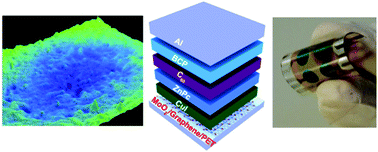Efficient organic photovoltaic cells on a single layer graphene transparent conductive electrode using MoOx as an interfacial layer†
Abstract
The large surface roughness, low work function and high cost of transparent electrodes using multilayer graphene films can limit their application in organic photovoltaic (OPV) cells. Here, we develop single layer graphene (SLG) films as transparent anodes for OPV cells that contain light-absorbing layers comprised of the evaporable molecular organic semiconductor materials, zinc phthalocyanine (ZnPc)/fullerene (C60), as well as a molybdenum oxide (MoOx) interfacial layer. In addition to an increase in the optical transmittance, the SLG anodes had a significant decrease in surface roughness compared to two and four layer graphene (TLG and FLG) anodes fabricated by multiple transfer and stacking of SLGs. Importantly, the introduction of a MoOx interfacial layer not only reduced the energy barrier between the graphene anode and the active layer, but also decreased the resistance of the SLG by nearly ten times. The OPV cells with the structure of polyethylene terephthalate/SLG/MoOx/CuI/ZnPc/C60/bathocuproine/Al were flexible, and had a power conversion efficiency of up to 0.84%, which was only 17.6% lower than the devices with an equivalent structure but prepared on commercial indium tin oxide anodes. Furthermore, the devices with the SLG anode were 50% and 86.7% higher in efficiency than the cells with the TLG and FLG anodes. These results show the potential of SLG electrodes for flexible and wearable OPV cells as well as other organic optoelectronic devices.


 Please wait while we load your content...
Please wait while we load your content...